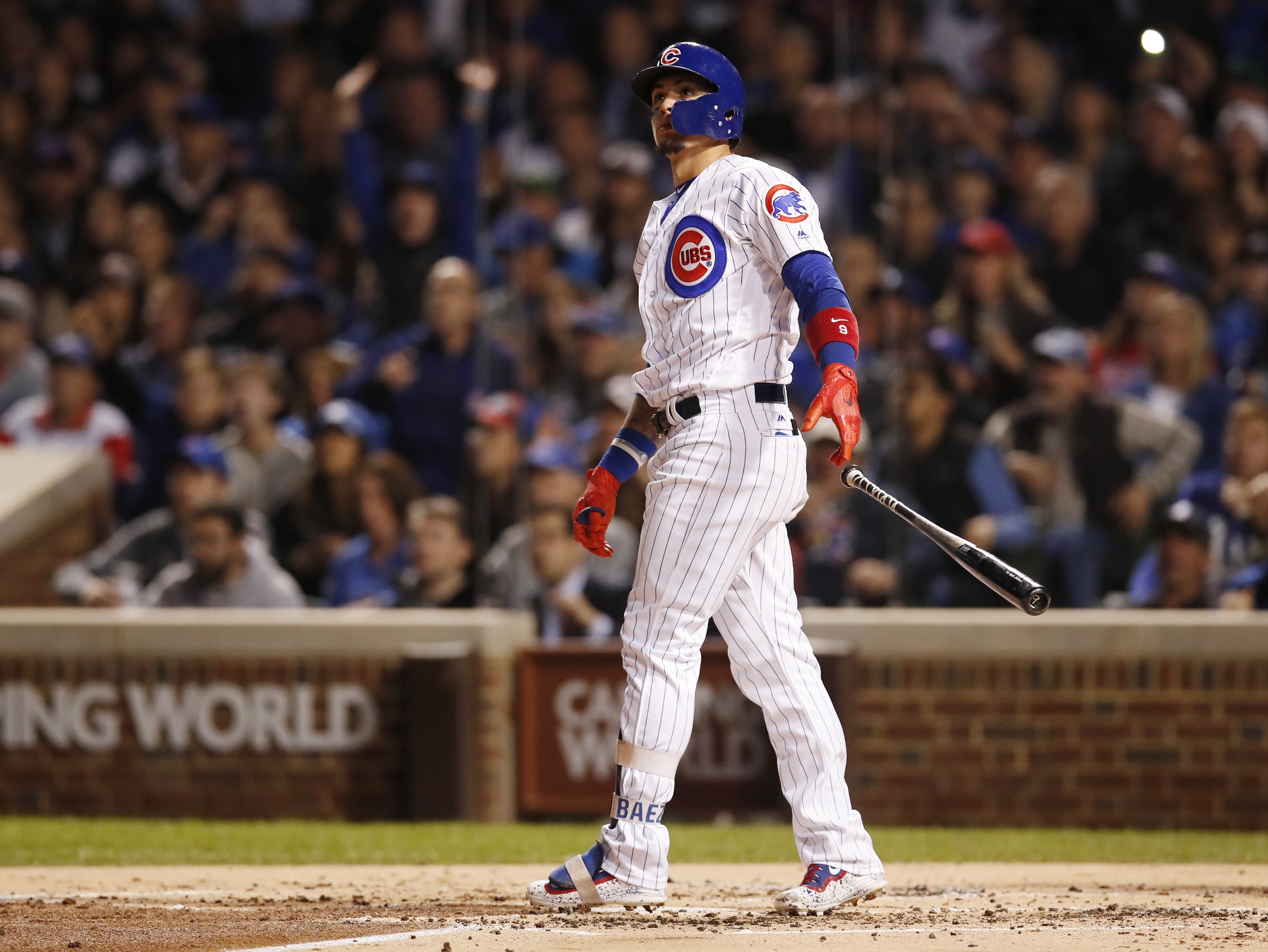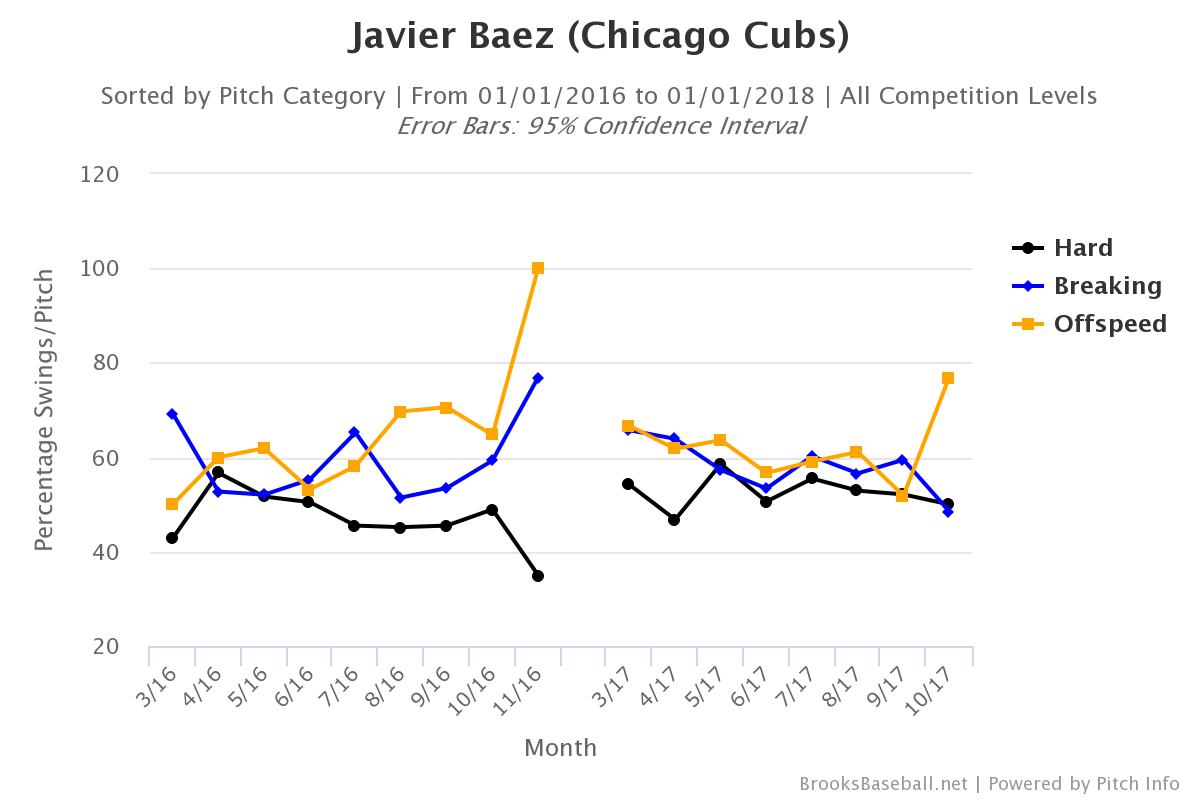It seems like every year, as spring creeps ever closer, I find myself asking the same questions about Javier Baez: What is he? Can his approach be fixed? Is there more OBP in there? A player that has always had immense upside, he came into the league as something of a wild card, with enormous power and natural ability on the defensive side. There were very serious questions about his approach and whether he’d ever perform consistently at the plate. While those questions are still somewhat present, Javy has managed to evolve into less of a wild card and more of a… predictable entity, for lack of a more effective term.
Baez’s first 229 plate appearances, back in 2014, were a total disaster, and ignited fears that he’d never be able to control himself at the plate. He reached base at a clip of only .227 and struck out over 40 percent of the time. The following year saw him only notch 80 plate appearances due to injury and far more time in the minor leagues than was initially expected, but he still posted a K% over 24 in Triple-A, and a mark over 30 percent at the big league level. But after a pair of seasons which produced extremely similar outputs, we may finally have Javy pinned for what he is.
| PA | AVG | OBP | ISO | K% | BB% | Tav | wRC+ | |
|---|---|---|---|---|---|---|---|---|
| 2016 | 450 | .273 | .314 | .150 | 24.0 | 3.3 | .275 | 94 |
| 2017 | 508 | .273 | .317 | .207 | 28.3 | 5.9 | .274 | 98 |
With the exception of the power side, represented by ISO, and a bit of fluctuation with respect to K/BB rates, that’s probably more consistency from year to year than any of us might have expected from Baez a couple of years ago. And given the strides he’s managed to make in regard to his approach and zone coverage, output like this could very well be the expectation moving forward. However, there are some notable drawbacks here, beyond Baez’s free-swinging tendencies. The fact that he relies so heavily on hard contact and, subsequently, BABIP in order to reach base could provide some obstacles in the event of a string of bad luck or a heavy influx of balls on the ground.
Baez has posted BABIP figures of .336 and .345, respectively, in the last two seasons. While he hasn’t reached base at a tremendous clip, he has managed to do so consistently despite high swing rates and low walk rates. More contact—Baez did experience a dip in his Contact% last season—could certainly benefit him and lead to that OBP coming up some in 2018 and beyond. Of course, there’s also the previously referenced potential of the opposite, with bad luck or some other factor impeding his progress. One hopes, though, that the power side would be enough to help Baez overcome such potential obstacles in the future.
The increase that Baez experienced with his isolated power was significant, and aiding him in his quest to flash the power with more regularity was the fact that he swung at hard stuff more often than he had in the previous season:
It all amounts to just over a five percent increase in swinging at hard stuff, which lends itself to more power, especially as far as someone with Baez’s bat speed is concerned. Baez also moved to the upper part of the zone, in terms of his swinging tendencies, from 2016 to 2017, which likely also supported his increased power numbers, regardless of pitch type.
Ultimately, while the numbers aren’t going to be entirely predictable, we have a pretty decent grasp of what Baez is as an offensive player. His approach, while we could see slight improvements, is kind of what it is at this point. He’s a free swinger who isn’t going to unintentionally walk much, and is a strikeout hazard even if his two-strike approach comes along ever-so-slightly. But if he can drive up those contact figures some, it could lead to an increased OBP. Combine that with the power numbers, which have always been a staple of his game, and there are certainly new heights which Baez can reach, but it’ll be the same exact skill set that gets him there.
Interestingly enough, the defensive side is where we might see some of that unpredictability begin to manifest itself for Baez in the coming months, given his propensity for wild throws, as demonstrated by his six throwing errors from the shortstop position, and eight overall. Not that anyone here would begin to question Baez’s defensive ability. I’ve gone on record stating that his defensive instincts and hands are as good as I’ve ever seen. And even if we can finally find an element of predictability within Baez, it’s not as if that’s going to make him any less astounding on a baseball field.
Of course, there’s still the wild card element surrounding his utilization, which could affect his number of plate appearances and perhaps his performance. But Joe Maddon is going to make sure Baez eats, and it’s going to be extremely interesting to observe if the consistency demonstrated by his statistical output in each of the last two seasons carries over to a third, or if the Javy Baez has more surprises in store for us.
Lead photo courtesy Jim Young—USA Today Sports


We also know what he is at 24.
What has been understated/maybe surprising about Baez is his ability that grow.
But if he can’t change the lack of plate discipline, by all means let’s hope his manager continues to hamstring him by batting him in front of the P. Hopefully, Maddon doesn’t further his development by continuing to sit him for lesser players; but for Russell’s injury in August, Baez would not have even had enough PAto qualify as full time.
Looking forward to an OPS over .800, another Fielding Bible Award, the team lead in SB, 660 PA—and a more protected spot in the order.